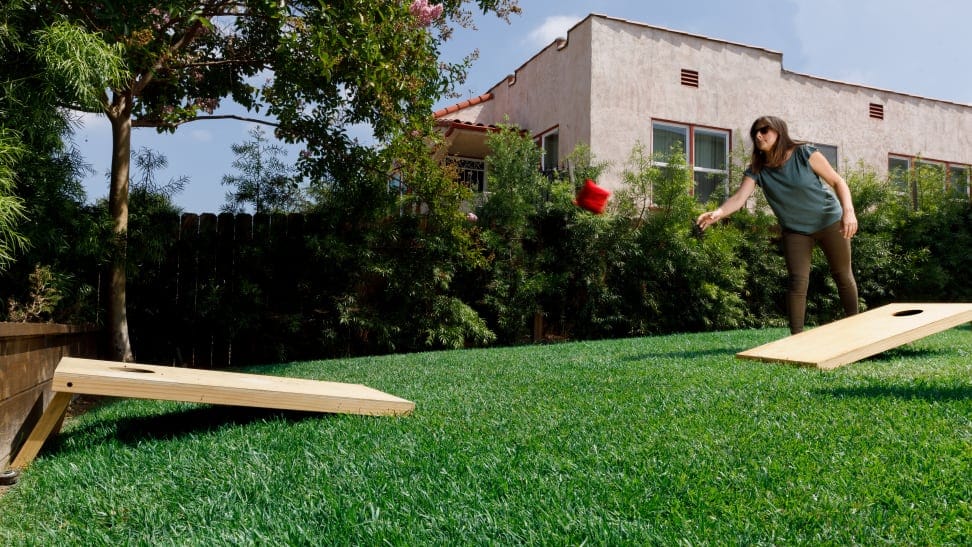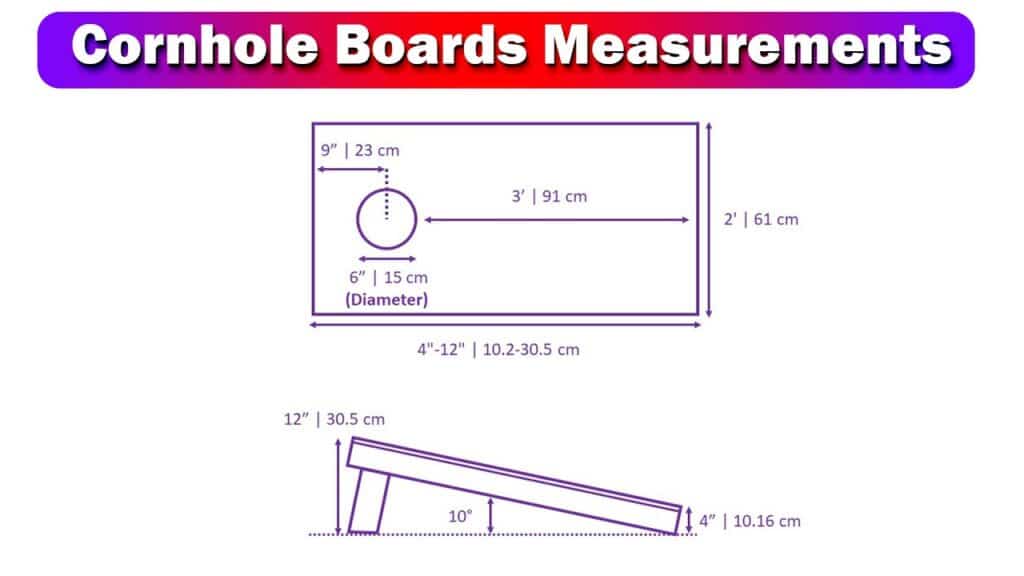“In the realm of outdoor gaming and tailgating, few activities have captured as much attention and devoted expertise as cornhole distance. This seemingly straightforward pastime, also known as bean bag toss, unites friends and family in friendly contests of precision and finesse.
While it may appear uncomplicated, the art of cornhole transcends mere bean bag throws toward wooden boards with holes. This article delves into the captivating domain of cornhole distance.

It examines the techniques, strategies, and physics behind achieving the perfect toss and reveals how it has transformed from a casual backyard game into a competitive sport.
Whether you’re a seasoned cornhole enthusiast or looking to enhance your skills at the next outdoor gathering, we welcome you to join us in unlocking the secrets of the ideal cornhole throw.
Read Also: 10 Secrets About GTA 6 Leaks
What is Cornhole Distance?
“Cornhole distance” primarily signifies the standardized separation between the two cornhole boards in a game of cornhole distance, also known as bean bag toss. In official cornhole matches, the distance between the foremost edges of the two boards is fixed at 27 feet (8.23 meters) for the typical adult version of the game.
This particular distance ensures an equitable and challenging playing field for participants. The precision of cornhole distance is paramount, as it significantly influences the difficulty and precision required to execute a successful bean bag toss into the hole on the opposing board.

Players must consistently assess and adapt their throws to accommodate this predetermined distance, making it an indispensable element of the game. While the distance may fluctuate in casual or informal games, in competitive settings, adherence to the official 27-foot distance is imperative to maintain the integrity of the sport.
Related: How Many Games Are in NBA Season?
How to Play Cornhole Distance
Cornhole Distance is an enjoyable and well-liked outdoor game suitable for individuals of all ages. The game typically unfolds in outdoor settings, with participants aiming to land bean bags on an elevated platform featuring a hole. Here’s a step-by-step guide on how to partake in a game of cornhole:
Equipment:
- Cornhole Boards: Procure two rectangular wooden boards, typically measuring 2 feet by 4 feet, featuring a hole near one end.
- Bean Bags: Acquire eight bean bags, typically distinguished by two sets of different colours (four bean bags in each set).
Game Setup
- Position the Boards: Place the two cornhole boards on a level, flat surface, ensuring that the front edges of the boards are set precisely 27 feet apart for standard gameplay (although this distance can be adjusted for informal matches).
- Form Teams: Divide participants into two teams, each consisting of either one or two players.
- Team Placement: Each team positions itself behind one of the cornhole boards, with the opposing team located behind the other board.
Gameplay:
- Commencing the Game: To determine which team initiates play, employ a method such as a coin toss or a game of rock-paper-scissors. The victorious team earns the privilege of the first throw.
- Scoring Points: The game’s objective revolves around amassing points by successfully landing bean bags in the hole on the opposing board or onto the board’s surface. Points are generally awarded as follows:
- Bag in the hole: 3 points.
- Bag on the board: 1 point.
- Alternate Throws: Teams take turns delivering their bean bags, with each team enjoying four consecutive throws. For instance, the first team member dispenses all four of their bean bags before the opposing team member takes their turn.
- Cancellation Scoring: At the conclusion of each round of throws, points are tallied for each team. In the event of one team scoring 2 points and the opposing team achieving 3 points within a round, the latter team secures 1 point for that round (3 points – 2 points). Only one team can earn points per round.
- Winning the Game: Typically, the game proceeds until one team reaches or surpasses 21 points, with the stipulation that victory must be claimed by a margin of at least 2 points.
- Winning the Match: In structured gameplay, a match often encompasses the best of three games. The team triumphing in two out of three games secured victory in the match.
Regulations and Guidelines for Cornhole Distance:
- A bean bag that makes contact with the ground prior to landing on the board is deemed invalid.
- If a bean bag initially lands on the board but is dislodged by another bag, it does not count as a point.
- Players must initiate throws from behind the board’s front edge.
Additional Suggestions:
- As a game rooted in skill, perfect your throwing technique to enhance precision.
- Some players employ distinct throwing styles, such as an underhand toss or a spinning motion.
- Engage in light-hearted banter and socialise with a drink in hand, as this is a common aspect of the cornhole experience.
Related: Paddle Tennis: A Comprehensive Review
Cornhole Distance Equipment:
To engage in a game of cornhole distance, you will require the following equipment:

- Cornhole Boards: These rectangular wooden platforms feature a hole near one end and are typically sized at 2 feet by 4 feet.
- Bean Bags: A set of eight bean bags, four in one colour and four in another, is essential. The bags are typically filled with corn kernels or beans and constructed from durable fabric with secure stitching.
- Measuring Tape: Useful for ensuring the regulation distance between boards (27 feet) when adhering to standard rules.
- Level Playing Surface: To facilitate board setup, ensure a flat, level surface, which may consist of grass, sand, or any outdoor terrain suitable for board placement.
- Scorekeeping: A scoreboard or scorekeeping system can aid in tracking points accumulated by each team. This can be as simple as a chalkboard, dry-erase board, or a piece of paper with a pen.
- Carrying Case (Optional): For the convenience of transporting and storing bean bags and boards, a carrying case can be a valuable addition, especially when you plan to take your cornhole set to different locations.
- Seating (Optional): To provide seating for players and spectators, consider having chairs or benches available.
- Refreshments and Snacks (Optional): Many participants relish playing cornhole with a beverage in hand and snacks on the side. Depending on the occasion, you can prepare a cooler with drinks and a table with snacks.
It’s important to note that the quality and design of cornhole equipment can vary. A diverse array of cornhole sets is available, featuring different themes and materials, from basic wooden boards to more decorative or personalized options.
For those participating in competitive or professional settings, it’s essential to ensure that your equipment complies with official regulations, particularly the board dimensions and hole size, to guarantee an equitable game.
Related: Google Doodle Baseball: All You Need to Know About The Sport
Cornhole Board Distance
In the game of cornhole distance, the standardized distance between the front edges of the two cornhole boards is established at 27 feet (8.23 meters) for traditional gameplay. This distance is recommended by the American Cornhole Association (ACA) and is widely adopted in organized cornhole distance competitions and competitive events.
The 27-foot separation is designed to create an equilibrium between challenge and precision, rendering it the standard for equitable competition. While informal cornhole matches might permit alterations to the distance to augment or diminish the game’s complexity, adhering to the 27-foot regulation is imperative in official tournaments.
Related: Yalla Shoot: All you Need to Know
Cornhole Distance Rules
Cornhole distance rules are integral to maintaining equity and consistency in the game, particularly within the framework of organized tournaments and competitive matchups. The following guidelines outline the customary regulations for the distance aspect of official cornhole play:
- Board-to-Board Distance:
- The prescribed distance separating the front edges of the two cornhole boards is 27 feet (equivalent to 8.23 meters) for typical gameplay. This distance should be ascertained from the nearest edge of one board to the nearest edge of the opposing board.
- Foul Line:
- A clearly defined foul line is typically designated, often marked using tape or another noticeable indicator. This line is positioned parallel to the boards and 27 feet distant from their front edge.
- Players are obligated to launch their bean bag throws from a position behind this line, with at least one foot maintaining contact or positioned behind the line during the release of the bean bag.
- Court Dimensions:
- The region encompassed between the two boards constitutes the playing court. To accommodate players and to assure an equitable playing environment, the court should possess a minimum width of 10 feet.
- Player Positions:
- Throughout the course of their throws, players are obliged to remain situated behind the foul line. Typically, only a singular team member from each team is permitted to execute throws during a given round of play.
- Pitching Mound (Where Applicable):
- Certain competitions or events may establish a specific pitching mound. This mound may be an elevated or level surface from which players are mandated to execute their throws. It is important to note that this rule is not universally applied, and in numerous instances, the designated foul line on the playing surface serves as the point of origin for throws.
- Foot Violations:
- Players are obligated to uphold proper footing behind the foul line during the execution of throws. Overstepping or crossing the foul line during a throw is deemed a foot fault, resulting in the nullification of the throw and the loss of any points that may have been scored during the throw.
- Interference Guidelines:
- Participants, spectators, and foreign objects must refrain from obstructing or interfering with the throws of the opposing team. The purpose of this rule is to ensure that games transpire fairly and without undue distractions.
It is imperative to acknowledge that while these distance rules represent the recognized standard for regulation cornhole, adaptations and variances may be present in informal and casual play, introducing alternative distances and regulations.
See Also: Mommy Milkers: Origin, Significance, and Implications
Cornhole Distance, the delightful and engaging lawn game, has captured the hearts of people of all generations. Whether it’s a casual gathering at a backyard barbecue or the intensity of competitive tournaments, cornhole weaves a tapestry of skill and camaraderie.
To fully relish the game, one must grasp the essentials: the right equipment, the perfect setup, and the adherence to distance rules. This trifecta ensures an equitable and demanding challenge.
As you embark on your cornhole adventure, keep in mind that this seemingly simple game is a test of precision and strategy. It’s an opportunity to connect with others, engage in friendly rivalries, and, above all, have a whole lot of fun.
With the regulation cornhole distance set at 27 feet, each toss becomes a quest for accuracy and finesse. So, grab your bean bags, assemble your boards, and embrace the enchanting world of cornhole.
Whether you aspire to that elusive hole-in-one or simply savour a leisurely throw in the sun, cornhole promises hours of joy and cherished moments with family and friends.
Related: Tyrone’s Unblocked Games: All You Need To Know
FAQs for Cornhole Distance
What is the official distance for Bean bag toss?
Set up your boards directly facing each other with 27 feet between the front edge of each board. Cornhole can be played with 2 or 4 players.
How far apart are ACL boards?
Boards i. 2 boards should be located exactly 27 feet (±1/2 inch) apart, from the front of one board to the front of another.
Why is it called cornholes?
when a player throws a bag into the hole, it is called a Cornhole, which tells us that the corn has been thrown into the hole.
